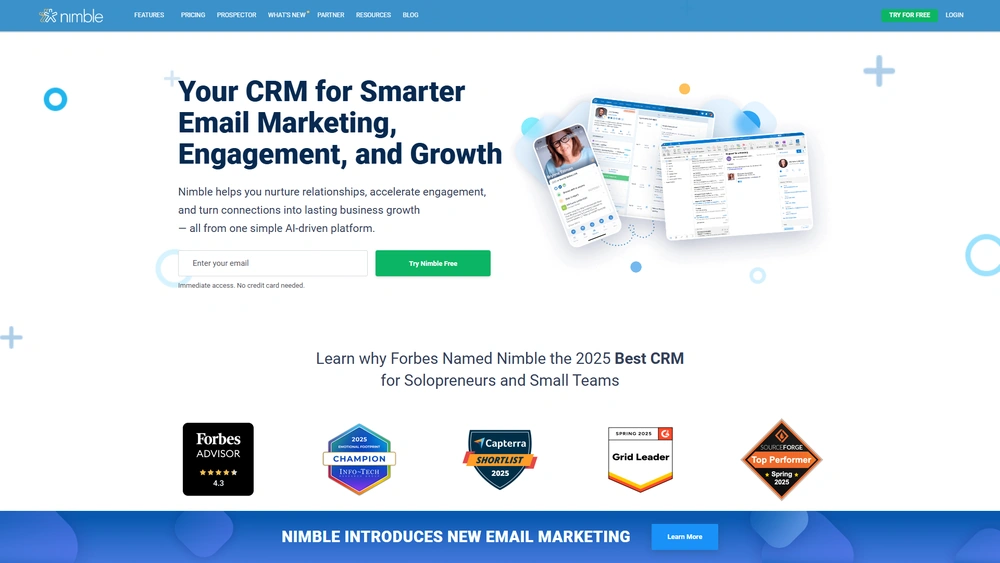Nimble Overview & 2025 Industry Position
Nimble is redefining what it means to manage business finances in a rapidly shifting regulatory and technological environment. Emerging as a forward-thinking platform focused on automating tax preparation, real-time expense tracking, and compliance alerts, Nimble Tax offers a streamlined, accessible experience for solopreneurs and small businesses. In 2025, as the demand for digitally nimble operations grows, Nimble positions itself at the intersection of simplicity and compliance, particularly for U.S.-based SMBs navigating complex income, sales, and self-employment tax requirements.
From Launch to 2025: Nimble’s Journey
Founded in 2021 by a team of fintech and regulatory tech veterans, Nimble began as a lightweight tax categorization assistant for gig workers. In 2022, it expanded into full-scope expense tracking and basic state tax calculators. By late 2023, Nimble introduced AI-suggested write-offs and quarterly filing reminders. The pivotal 2024 update integrated with major accounting platforms and marketplaces, positioning Nimble as more than a tracker—now a proactive tax automation engine.
In 2025, Nimble’s strategy is clear: become the default backend compliance layer for U.S.-based micro-entities and side hustlers, combining automation with education through an intuitive UX-first approach.

Nimble Key Features
Nimble delivers a compact but powerful suite of capabilities built for the modern micro-business. Here are its 2025 highlights:
- Automated Tax Intelligence™: AI-tagging of expenses for write-offs, sales tax, and income categorization.
- Smart Calendar: Real-time reminders for federal/state quarterly and annual filings.
- Write-off Engine: Scans bank transactions and flags overlooked tax deductions.
- Multi-source Income Sync: Connects bank accounts, PayPal, Stripe, Etsy, etc., auto-importing income.
- State-specific Tax Intelligence: Tailored alerts for sales tax thresholds and nexus rules by state.
- User-centric Interface: Built to support non-accountants navigating complex tax flows.
Workflow & UX
Nimble’s interface is clean, visual, and optimized for mobile-first usage. Upon login, users see a centralized dashboard showing tax due estimates, write-off suggestions, and pending deadlines. With drag-and-drop ease, users can reclassify income or categorize expenses. Setup flow requires linking financial accounts using Plaid, taking less than 3 minutes. The visual tax calendar is color-coded, and each line item includes contextual tooltips.
Pro Tip: If you operate in multiple states, enable Nimble’s sales tax alerts to avoid triggering surprise nexus penalties.
Nimble Pricing Analysis & Value Metrics
| Plan | Monthly Price | Key Inclusions |
|---|---|---|
| Basic | $9/month | Expense categorization, tax estimates, 1 account sync |
| Pro | $19/month | Multiple accounts, state tax alerts, live support |
| Growth | $39/month | AI-optimized deductions, integrations, quarterly filing portal |
For solopreneurs and 1099 contractors with multi-stream income, Nimble’s Pro or Growth tiers offer exceptional value—providing accountant-level oversight without the overhead cost.
Competitive Landscape
| Service | Best For | Key Differentiator | Typical Cost |
|---|---|---|---|
| Nimble | Gig workers, solopreneurs | Real-time tax alerts, seamless interface | $9–$39/mo |
| Keeper Tax | Freelancers | SMS-based deduction alerts | $20/mo |
| QuickBooks Self-Employed | Established freelancers | Invoicing + accounting | $25/mo |
| Hurdlr | Side hustlers | Mileage + tax tracking | $12/mo |
Use Cases
- Etsy sellers juggling income from Stripe and PayPal.
- 1099 consultants needing quarterly tax estimate guidance.
- Content creators tracking influencer brand deals + affiliate payouts.
- Side-hustlers earning revenue across multiple gig platforms.
- Startup founders without finance teams, managing their own compliance.
Integrations & Ecosystem
Nimble Integrations include top-tier connectivity with:
- Banking: Chase, Wells Fargo, BofA, Capital One (via Plaid)
- Payments: Stripe, Square, PayPal
- Marketplaces: Etsy, Shopify, Amazon Seller Central
- Bookkeeping: QuickBooks, Xero exports
Unlike traditional accounting apps, Nimble adds tax compliance overlays without duplicating accounting functionality, making it lightweight and symbiotic to existing workflows.
Pros & Cons
- Pros:
- Real-time tax automation without full accounting complexity
- Intuitive interface with powerful write-off logic
- Excellent support, including contextual help overlays
- Affordable even for part-time side hustlers
- Cons:
- No invoicing or generalized accounting features
- Doesn’t support C-corp-level filings
- Limited in-app education vs full-service firms
Final Thoughts
Nimble isn’t designed to replace your accountant—it’s designed to delay when you’ll actually need one. For freelancers, creators, and early-stage founders who outgrow spreadsheets but aren’t ready for full-scale accounting software, it’s a quiet powerhouse. The platform’s ability to reduce tax stress while transparently guiding compliance makes it an essential part of any 2025 solo business stack.
Nimble FAQ
No, Nimble does not directly file state or federal taxes. It provides categorized exports and filing-ready summaries.
Nimble is currently optimized for U.S. self-employment and small business tax systems. International support is limited.
Yes, Nimble uses PLAID for bank connections and end-to-end encryption to secure all financial data.
Freelancers, Etsy sellers, independent contractors, content creators, and micro-LLCs are common Nimble users.
Yes. Nimble exports clean CSV summaries for upload into QuickBooks and other accounting tools.